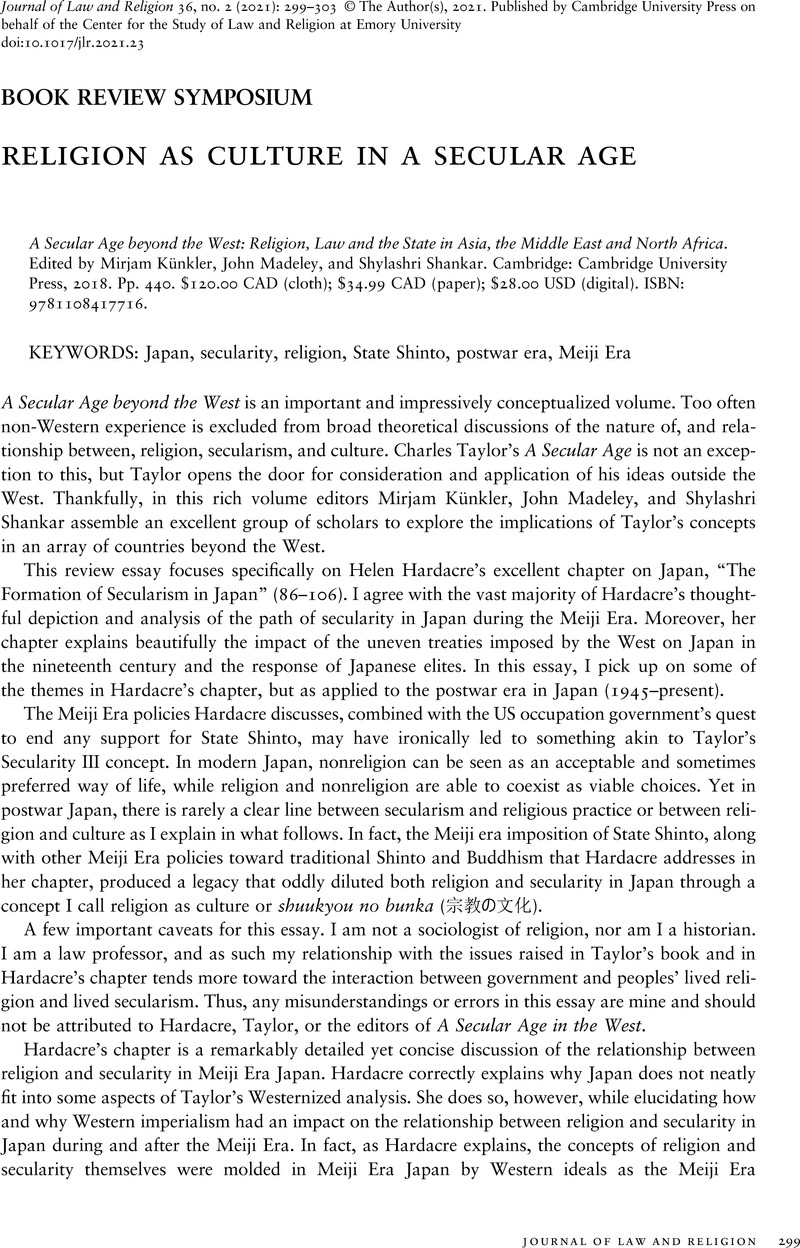No CrossRef data available.
Article contents
RELIGION AS CULTURE IN A SECULAR AGE - A Secular Age beyond the West: Religion, Law and the State in Asia, the Middle East and North Africa. Edited by Mirjam Künkler, John Madeley, and Shylashri Shankar. Cambridge: Cambridge University Press, 2018. Pp. 440. $120.00 CAD (cloth); $34.99 CAD (paper); $28.00 USD (digital). ISBN: 9781108417716.
Published online by Cambridge University Press: 28 June 2021
Abstract

- Type
- Book Review Symposium: A Secular Age Beyond the West
- Information
- Copyright
- Copyright © The Author(s), 2021. Published by Cambridge University Press on behalf of the Center for the Study of Law and Religion at Emory University
References
1 Often referred to as haibutsu kishaku (廃仏毀釈) or abolition of Buddhism, and described well in Hardacre's chapter, it was supported in part by a series of anti-Buddhist edicts and laws. Ketelaar, James Edward, Of Heretics and Martyrs in Meiji Japan: Buddhism and Its Persecution (Princeton: Princeton University Press, 1993)Google Scholar.
2 Hardacre's chapter effectively lays out both the role of Meiji era elites and the government in trying to meet this goal.
3 Ravitch, Frank S., “The Shinto Cases: Religion, Culture, or Both-The Japanese Supreme Court and Establishment of Religion Jurisprudence,” Brigham Young University Law Review 2013, no. 3 (2013): 505–20Google Scholar, at 505, 506–08. For an interesting discussion of this from a Meiji era perspective see, Hozumi, Nobushige, Ancestor Worship and Japanese Law (Tokyo: Maruzen Kabushiki-Kaisha, 1913)Google Scholar.
4 Ravitch, “The Shinto Cases,” 506.
5 See, for example, Nishi Amane, “Kyoumonron,” Meiroku Zasshi 4, no 12 (1874).
6 An exception cited by Hardacre is Braisted, William Reynold, Meiroku Zasshi, Journal of the Japanese Enlightenment (Cambridge, MA: Harvard University Press, 1976)Google Scholar; see also Havens, Thomas R. H., Nishi Amane and Modern Japanese Thought (Princeton: Princeton University Press, 1970)Google Scholar.
7 Havens, Nishi Amane, 180–85.
8 Havens, Nishi Amane, 180–85; see also Amane, “Kyoumonron.”
9 “Christian” weddings in Japan rarely involve an actual Christian ceremony. They are often referred to as “church weddings,” and the person dressed as priest or minister is rarely either. In Japan, marriage is legally a civil matter, Colin P. A. Jones and Frank S. Ravitch, The Japanese Legal System (St. Paul: West Academic Publishing, 2018), 301–03, 307, and the kekkon-shiki, or wedding ceremony is separate from the legal marriage. Many people want to have a wedding ceremony like they have seen in the mostly Western movies, and those often take the form of Christian ceremonies. There is an entire wedding hall industry where chapels with crosses and actors playing ministers or priests are common. As I have personally experienced, this can lead to some interesting situations when a non-Christian Westerner does not want to be married in front of a cross or by someone dressed as a Christian minister, and has to explain to a Japanese partner, catering hall staff, and others that to many the cross is a powerful sectarian religious symbol and not just a decoration for a marriage. It should be noted, however, that many Japanese wedding ceremonies still follow the tradition Shinto customs.
10 Robert Kisala, “Japanese Religions,” in Nanzan Guide to Japanese Religions, ed. Paul L. Swanson and Clark Chilson (Honolulu: University of Hawaii Press, 2006), 3–13, at 3.
11 In recent years there have been numerous stories in the Japanese news about people moving away from traditional Buddhist funerals due to the expense, and even attempts to automate or virtually perform aspects of funeral rights.
12 For an interesting discussion of these definition problems in a finite context see, Winnifred Fallers Sullivan, The Impossibility of Religious Freedom (Princeton: Princeton University Press, 2005).
13 Ravitch, Frank S., “The Unbearable Lightness of Free Exercise under Smith: Exemptions, Dasein, and the More Nuanced Approach of the Japanese Supreme Court,” Texas Tech Law Review 44, no. 1 (2011): 259–79Google Scholar, at 259.
14 Ravitch, “The Unbearable Lightness,” 260.
15 Ravitch, 260.
16 Kitagawa, Joseph M., Religion in Japanese History (New York: Columbia University Press, 1990)Google Scholar.
17 See Amane, “Kyoumonron.”
18 Helen Hardacre, Shinto and the State 1868–1988 (Princeton: Princeton University Press, 1989); Ravitch, “The Shinto Cases,” 507–08.
19 Helen Hardacre, Shinto and the State; Ravitch, “The Shinto Cases,” 507–08.
20 Nihonkoku Kenpo [The Constitution of Japan] art. IIX, VIIIXIX.
21 This was also necessary as a matter of law, because the Meiji constitution could be amended or replaced only with the approval of the emperor, and the occupation government did not want the legality of the new constitution to be in question. Jones and Ravitch, The Japanese Legal System, 162.
22 Jones and Ravitch, The Japanese Legal System, 160–64.
23 See Ravitch, “The Shinto Cases”; Ravitch, “The Unbearable Lightness.”



